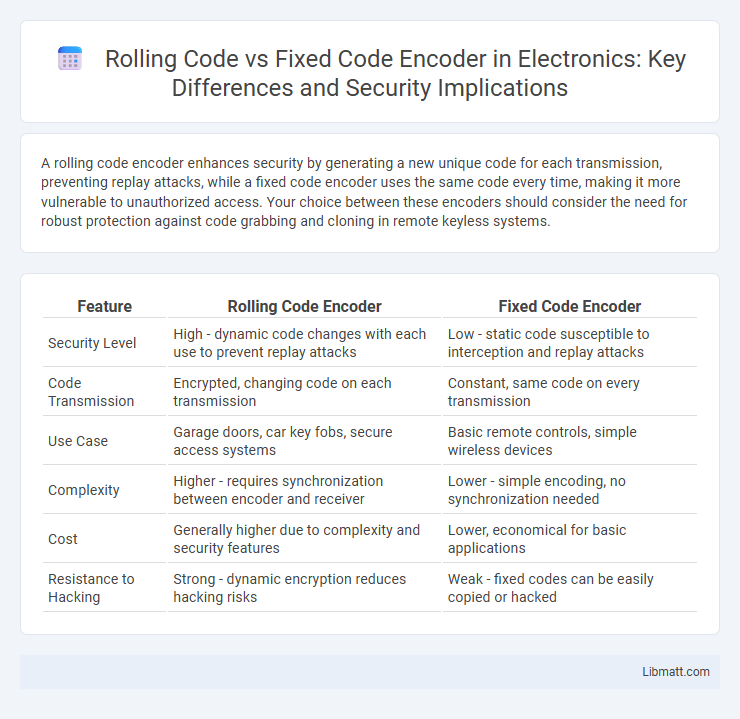A rolling code encoder enhances security by generating a new unique code for each transmission, preventing replay attacks, while a fixed code encoder uses the same code every time, making it more vulnerable to unauthorized access. Your choice between these encoders should consider the need for robust protection against code grabbing and cloning in remote keyless systems.
Table of Comparison
| Feature | Rolling Code Encoder | Fixed Code Encoder |
|---|---|---|
| Security Level | High - dynamic code changes with each use to prevent replay attacks | Low - static code susceptible to interception and replay attacks |
| Code Transmission | Encrypted, changing code on each transmission | Constant, same code on every transmission |
| Use Case | Garage doors, car key fobs, secure access systems | Basic remote controls, simple wireless devices |
| Complexity | Higher - requires synchronization between encoder and receiver | Lower - simple encoding, no synchronization needed |
| Cost | Generally higher due to complexity and security features | Lower, economical for basic applications |
| Resistance to Hacking | Strong - dynamic encryption reduces hacking risks | Weak - fixed codes can be easily copied or hacked |
Introduction to Code Encoders
Code encoders translate mechanical movement into electrical signals for precise control in devices like remote controls and security systems. Rolling code encoders generate a unique code every time, enhancing security by preventing code replay attacks, while fixed code encoders use a constant code, making them simpler but more vulnerable to interception. Understanding the differences between rolling code and fixed code encoders helps you select the appropriate technology for your security and control system needs.
What is Fixed Code Encoding?
Fixed code encoding uses a pre-set, unchanging digital code stored within an encoder and decoder to control devices like garage doors or car alarms. Unlike rolling code systems that generate a new code with every use to enhance security, fixed code encoders transmit the same signal each time, making them simpler but more vulnerable to code grabbing or replay attacks. When choosing your security setup, understanding that fixed code encoding offers basic functionality with less protection against modern cyber threats is crucial.
How Rolling Code Encoding Works
Rolling code encoding generates a new, unique code each time the transmitter is activated, utilizing a synchronized algorithm between the encoder and receiver to prevent replay attacks. This dynamic code changes based on a cryptographic sequence, ensuring that previously transmitted codes cannot be reused by unauthorized devices. The continuous code variation enhances security compared to fixed code encoders, which use static codes vulnerable to interception and duplication.
Security Differences: Rolling Code vs Fixed Code
Rolling code encoders offer enhanced security by generating a new code for every transmission, preventing replay attacks that fixed code encoders are vulnerable to due to their static code usage. Fixed code systems can be easily intercepted and duplicated by attackers, compromising the integrity of your access control. Choosing a rolling code encoder significantly reduces the risk of unauthorized entry by ensuring that each transmitted signal is unique and cannot be reused.
Advantages of Rolling Code Encoders
Rolling code encoders enhance security by generating a unique code each time a device is used, preventing replay attacks commonly associated with fixed code systems. These encoders use synchronized algorithms between transmitter and receiver to ensure codes are valid for one-time use only, significantly reducing the risk of unauthorized access. Their dynamic encryption approach maintains robust protection in applications like garage door openers, keyless entry systems, and remote controls.
Limitations of Fixed Code Encoders
Fixed code encoders have limited security due to their static signal patterns, making them vulnerable to code grabbing and replay attacks. Their fixed sequence of codes allows attackers to intercept and duplicate the signal for unauthorized access. This lack of dynamic code variation restricts their effectiveness in modern secure communication systems.
Common Applications in Everyday Devices
Rolling code encoders are commonly used in car key fobs and garage door openers to enhance security by generating a new code with each use, preventing unauthorized access. Fixed code encoders appear in simpler devices like basic remote controls and older alarm systems, where security requirements are lower and the code remains constant. Your choice between these encoders depends on the level of protection needed for everyday applications.
Vulnerabilities and Hacking Risks
Rolling code encoders generate a new code for each use, significantly reducing vulnerabilities by preventing replay attacks common in fixed code systems, which transmit the same code every time. Fixed code encoders face higher hacking risks since attackers can easily capture and reuse the signal to gain unauthorized access. Your security is enhanced with rolling code technology, as it dynamically changes the code after every use, making it far more resistant to interception and cloning attempts.
Choosing the Right Encoder for Your Needs
Choosing the right encoder depends on your security and convenience requirements. Rolling code encoders generate a new code with every use, greatly enhancing security against replay attacks, making them ideal for garage doors and car key fobs. Fixed code encoders transmit the same code each time, offering simplicity and cost-effectiveness, suitable for basic remote controls and older systems where high security is not critical.
Future Trends in Code Encoder Technology
Future trends in code encoder technology focus on enhancing security and adaptability through advanced encryption algorithms and AI-driven dynamic key generation, surpassing traditional rolling and fixed code systems. Rolling code encoders are evolving with more complex frequency hopping and multi-factor authentication to counteract signal interception and replay attacks. Fixed code encoders are being phased out in favor of dynamic, cloud-connected solutions that enable real-time code updates and increased resistance against cloning and hacking attempts.
Rolling code vs Fixed code encoder Infographic

 libmatt.com
libmatt.com